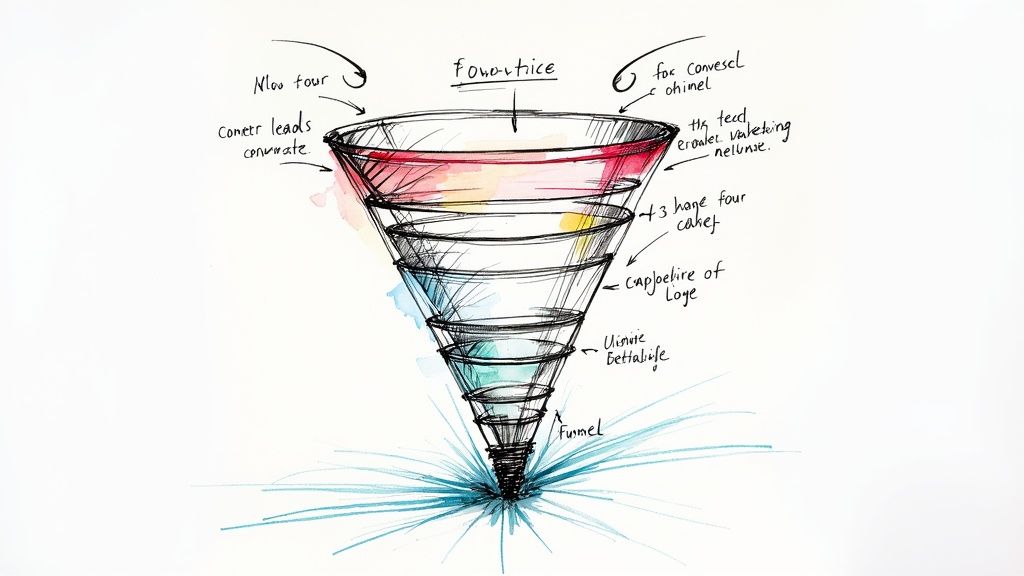Lead Generation Best Practices
Understanding Today's Lead Generation Landscape

The way businesses find and connect with potential customers has fundamentally changed. Modern buyers now research extensively online before ever talking to sales teams. This new reality means companies need to move beyond traditional outbound tactics and focus on building meaningful connections with prospects.
The Shift Towards Quality Over Quantity
Smart businesses now prioritize finding the right prospects rather than just gathering large lists of leads. Instead of sending mass messages hoping something sticks, companies focus on engaging smaller groups of highly interested potential customers. This targeted approach leads to better conversion rates and builds stronger long-term relationships.
Challenges and Opportunities in Modern Lead Generation
Lead generation remains difficult for many companies to get right. Studies show that 61% of marketers consider it their biggest challenge, while only 20% of qualified leads receive proper follow-up (See full lead generation statistics). However, these challenges create opportunities for businesses willing to adapt their approach and use the right tools effectively.
Adapting to Evolved Buyer Expectations
Today's buyers expect personalized experiences and helpful information before making purchase decisions. They tend to ignore aggressive sales tactics but engage well with brands that provide real value through educational content and genuine relationship building. Companies that understand and act on these preferences gain a real advantage.
Embracing New Technologies and Best Practices
Success in modern lead generation requires using the right mix of tools and strategies:
- Data-driven decisions: Using analytics to improve targeting and messaging
- Sales and marketing alignment: Creating smooth handoffs between teams
- Multiple acquisition channels: Building a reliable pipeline of leads
- Smart automation: Making follow-up and nurturing more efficient
- Quality content creation: Developing materials that attract and inform prospects
By focusing on these key areas and staying flexible as buyer needs evolve, businesses can build effective lead generation programs that deliver consistent results. The key is maintaining a careful balance between using helpful technology and keeping the human element that builds lasting customer relationships.
Choosing Cost-Effective Lead Generation Channels
Making smart choices about lead generation channels determines whether your marketing budget delivers results or goes to waste. The key is finding platforms that work specifically for your business - not just following the crowd. To make the best choice, you need to look carefully at who you're trying to reach, what your industry needs, and how much you can spend.
Understanding Channel Effectiveness
When measuring how well a channel works, don't just count the number of leads. Pay attention to their quality and how much each one costs you. For instance, some platforms might bring in lots of contacts, but if they rarely become customers, you're wasting resources. Focus on channels that deliver leads who match your ideal customer profile and have a real chance of buying.
Balancing Inbound and Outbound Strategies
The most successful companies use both inbound and outbound methods to find leads. Think of it like fishing - inbound is like setting up nets (content marketing, SEO) to catch interested prospects, while outbound is actively casting lines (email campaigns, ads) to reach specific targets. Using both approaches helps you connect with more potential customers in different ways.
Diversifying Your Channel Mix
Putting all your eggs in one basket is risky when it comes to lead generation. If your main channel stops performing well, your lead flow could dry up overnight. That's why smart businesses use multiple methods - from social media and email to webinars and industry events. This creates a steady stream of leads from different sources, making your strategy more stable and reliable.
The money you spend on leads can vary hugely between channels. Data shows that retargeting ads and SEO are budget-friendly, costing about $31 per lead. But trade shows and events? They'll set you back around $811 per lead. Knowing these numbers helps you spend wisely. Learn more about lead generation costs in this detailed cost analysis guide.
Aligning Channels with Your Target Audience
Different channels attract different types of people. Before spending money on any platform, make sure you understand your ideal customer profile - who they are, where they spend time online, and how they prefer to learn about products. If your target customers are active professionals on LinkedIn, that's where you should focus your efforts rather than spreading yourself thin across every social network.
Optimizing Channel Performance
Success in lead generation requires constant fine-tuning. Keep a close eye on key metrics like conversion rates and cost per acquisition to spot what needs improvement. Test different messages, adjust your targeting, and try new content formats to see what works best. Pay attention to how your audience responds and be ready to shift your approach when something isn't working. Regular analysis and adjustments help you build a reliable system for bringing in qualified leads month after month.
Measuring and Optimizing Lead Generation ROI

Getting leads is one thing - knowing if your efforts are paying off is another. Let's explore how to measure and improve the returns on your lead generation investments. With the right data and metrics, you can make smart decisions about where to focus your resources.
Key Metrics for Measuring Lead Generation ROI
To really understand if your lead generation is working, you need to track several important numbers. Here are the essential metrics that show you the full picture:
- Cost Per Lead (CPL): How much do you spend to get one new lead? The goal is to reduce this cost while keeping lead quality high.
- Conversion Rate: What percentage of leads become customers? Higher numbers here mean your process is working well.
- Customer Lifetime Value (CLTV): How much revenue does each customer generate over time? This helps you decide how much to spend on marketing.
- Sales Cycle Length: How long does it take to turn a lead into a customer? Shorter cycles mean faster revenue.
Calculating and Interpreting ROI
Getting clear on your ROI means looking at the money spent versus money earned. You'll want to track your marketing costs, number of leads, how many leads convert, and the revenue they generate. For a detailed breakdown on calculating lead generation ROI, check out this guide from Pro Sales Connection. A simple example: spending $1,000 to earn $3,000 gives you a 200% ROI.
Using Analytics to Optimize Lead Generation
Good data helps you make better choices. Tools like Google Analytics show you how leads behave and which marketing channels work best. You can use this information to:
- Target the right audiences
- Craft better messages
- Test different approaches
- Focus on what works
Focusing on Key Performance Indicators (KPIs)
While there are many numbers you could track, pick a few key metrics that match your goals. If you want more revenue, focus on conversion rates and customer value rather than just lead costs. These focused metrics help keep your team aligned and moving in the right direction.
Regular measurement and adjustment keep your lead generation on track. By watching the numbers, testing new ideas, and adapting when needed, you build a system that consistently delivers results. Remember that improvement is ongoing - keep testing, learning, and refining your approach based on what the data tells you.
Building an Effective Lead Nurturing Strategy

Lead nurturing is much more than just collecting contact information - it's about building meaningful relationships with potential customers. The most successful companies combine automated systems with personal touches to connect with prospects in an authentic way. This approach helps guide leads naturally through the sales process until they're ready to make a purchase.
Content Mapping for the Buyer's Journey
The key to effective nurturing is delivering helpful content that matches where prospects are in their decision process. During the early awareness stage, people are just starting to understand their problems, so focus on educational content that explains potential solutions. As they move into researching options, provide more specifics about your offerings and how they solve key challenges. For prospects nearing a decision, share detailed case studies and customer stories that build confidence in choosing your solution.
The Power of Personalization and Automation
Small personal touches make a big difference in nurturing relationships. Using someone's name, mentioning their industry, or referencing past interactions shows you understand and value them as individuals. Since personalizing everything manually isn't realistic for most teams, marketing automation tools help deliver customized messages based on how prospects engage with your content - whether that's visiting specific pages, downloading resources, or clicking email links.
Using Behavior Data to Guide Communication
Smart companies pay close attention to how prospects interact with their content to understand what matters most to them. When someone downloads information about a particular feature or service, for example, you can automatically send them more details about that specific topic. By tracking engagement patterns over time, you can also spot high-interest leads who are showing strong buying signals and prioritize follow-up accordingly.
Optimizing for Conversion
The end goal is turning prospects into customers, which requires continuous improvement of your nurturing process. Keep a close eye on key metrics like email opens, content engagement, and conversion rates to see what's working. Regular analysis helps identify areas to adjust and refine your approach. Testing and optimizing your nurturing system over time leads to better results and more consistent revenue growth.
Aligning Sales and Marketing for Better Lead Conversion

When sales and marketing teams work together closely, organizations see much better results in converting leads into customers. By coordinating their efforts and sharing key information, these teams can make sure potential customers get the right attention at the right time. Let's explore how to build this effective partnership.
Breaking Down Traditional Silos
In many companies, sales and marketing teams have worked separately with different goals and success metrics. This disconnect often leads to qualified leads falling through the cracks or receiving mismatched follow-up. For example, marketing might generate lots of leads that sales considers poor quality, while sales might ignore promising leads that just need more nurturing. Creating shared objectives and regular team communication helps prevent these issues.
Establishing Shared Definitions and Processes
Success starts with getting everyone speaking the same language. Teams need clear definitions for terms like Marketing Qualified Leads (MQLs) and Sales Qualified Leads (SQLs). For instance, marketing and sales should agree on specific criteria that make a lead "sales-ready." This clarity helps both teams focus their efforts on the right prospects at the right time.
Implementing Effective Hand-Off Processes
The hand-off between marketing and sales needs clear guidelines. This includes specific triggers for when marketing should pass leads to sales, like when someone downloads a pricing guide or requests a demo. Sales should also know exactly what information they'll receive about each lead and what actions to take. Regular feedback between teams helps refine these processes over time.
Maintaining Clear Communication Throughout the Sales Cycle
Ongoing communication keeps leads from slipping away. Sales reps should update marketing on which leads convert best, while marketing should share insights about prospect behavior and engagement. When sales notices certain types of leads close more often, marketing can adjust their targeting. This back-and-forth helps both teams improve their results.
Utilizing Technology and Data for Transparency and Accountability
Good tools make alignment much easier. A solid Customer Relationship Management (CRM) system lets both teams track leads from first touch to final sale. With the right technology, everyone can see how leads progress and where they might get stuck. Teams can then use this data to spot patterns, fix problems, and focus on what works best. Regular reporting helps keep everyone accountable and shows the real impact of working together.
Future-Proofing Your Lead Generation Strategy
Lead generation strategies change as buyer needs evolve. Businesses that adapt and plan for future trends while maintaining proven fundamentals put themselves in the best position to succeed. Let's explore key areas to focus on when building a future-ready lead generation program.
The Impact of AI and Automation
AI tools are changing how businesses connect with potential customers. Smart automation helps personalize interactions and sorts through data to find the most promising leads. This frees up sales and marketing teams to build deeper relationships. A simple example is AI chatbots that can talk to website visitors at any hour, asking qualifying questions even when the sales team is offline. Teams can then focus their energy on the leads most likely to convert.
Adapting to Changing Buyer Behaviors
Today's buyers do their homework before talking to sales teams. They look for personalized experiences and helpful content that speaks directly to their challenges. Generic marketing messages often fall flat. The key is using data-driven insights to understand what different buyer groups care about and crafting messages that resonate with each segment's specific needs.
Embracing Emerging Technologies
While AI gets much attention, other tech advances are reshaping lead generation too. Take dark social - the growing trend of people sharing content through private messages and chat apps. Though harder to track, these private channels often produce highly interested prospects. Keeping up with new communication platforms helps businesses meet potential customers where they naturally spend time.
Balancing New Tools With Foundational Best Practices
Adding new technology works best when built on solid fundamentals. Key areas to maintain include:
- Mix of inbound and outbound: Blend helpful content that attracts prospects with targeted outreach to specific accounts
- Multiple lead sources: Build a diverse program across email, social, events, and content to reduce risk
- Sales-marketing teamwork: Ensure smooth handoffs and consistent messaging through close collaboration
Building a Sustainable and Adaptable Lead Generation Program
Creating a future-ready program means building for both stability and flexibility. Just as new case studies help build trust, regular testing and measurement help strengthen your approach over time. Stay curious about industry changes, but test new ideas carefully. Focus on what works while remaining open to fresh approaches that could improve results.
Looking to optimize your lead generation with the power of AI? Sitebot empowers businesses to create custom AI chatbots tailored to their unique content and brand. Visit Sitebot today to learn more and transform your customer interactions.


